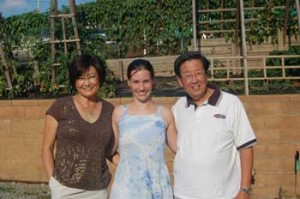Recipient of the Dr. & Mrs. Savio L-Y. Woo Research Scholarship
 In the summer of 2010, I was honored to receive the Dr. and Mrs. Savio L- Y. Woo Research Scholarship. Through this great opportunity, I was able to conduct research as an intern and gain experience in a field that I intend to work once I graduate. I am currently a Junior in the Department of Mechanical Engineering at California State University (CSU), Chico – the school that Dr. Woo also received his B.S. degree in Mechanical Engineering. My work at the Musculoskeletal Research Center (MSRC), Department of Bioengineering, University of Pittsburgh involved analyzing the movement of an EndoButton/Hamstrings construct within the femoral bone tunnel after ACL reconstruction.
In the summer of 2010, I was honored to receive the Dr. and Mrs. Savio L- Y. Woo Research Scholarship. Through this great opportunity, I was able to conduct research as an intern and gain experience in a field that I intend to work once I graduate. I am currently a Junior in the Department of Mechanical Engineering at California State University (CSU), Chico – the school that Dr. Woo also received his B.S. degree in Mechanical Engineering. My work at the Musculoskeletal Research Center (MSRC), Department of Bioengineering, University of Pittsburgh involved analyzing the movement of an EndoButton/Hamstrings construct within the femoral bone tunnel after ACL reconstruction.
Construct movement within the bone tunnel is referenced in literature as having a possible negative effect on bone growth after surgery. However, this hypothesis has never been tested explicitly. Whether the absence of movement of the construct creates the optimal environment for bone growth, or is some movement preferable, has yet to be determined. The MSRC decided to study these questions through the use of a bioadhesive developed by Cohera. The glue like substance was designed to restrict construct move- ment within the bone tunnel. Once this is achieved, the properties of the bioadhesive could be altered to allow various magnitudes of movement.
This project had only just begun when I arrived at the MSRC. After educating myself on the subject, I started to design a testing protocol under the guidance of Mr. Kwang Kim. Using literature for reference, a procedure for testing the bioadhesive on porcine models was established. The bioadhesive was still in development when I ran my first test. The results showed that it did not restrict the movement of the construct, and that further development was necessary before it could be considered a viable option for this study. Our group then discussed the changes that should be made before the next round of testing.
With further development of the bioadhesive, testing will commence in earnest. Once the data has been analyzed, and an optimal degree of vibration reached, an in vivo test could then be contemplated. Until then, the MSRC and the Cohera design team will work in tandem to obtain a suitable bioadhesive.
This was my first opportunity to conduct research in my area of interest, and it would not have been possible without support of Dr. Kenneth Derucher, Former Dean and Professor of Civil Engineering at CSU, Chico and the generosity of the Woo Research Scholarship. I feel that the knowledge that I have gained from this experience has helped prepare me to more confidently pursue a career in the field of Biomechanics. Finally, I would like to thank the ASIAM Institute Board of Directors and Dr. and Mrs. Woo for this prestigious scholarship.
